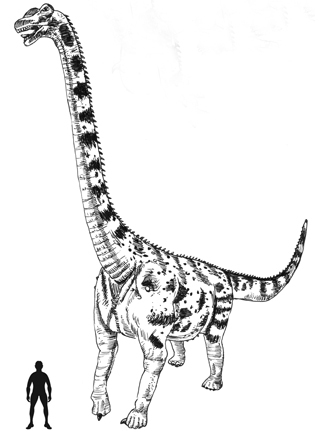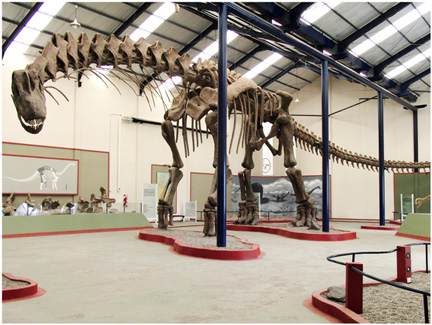Argentinosaurus Walks Again After 94 Million Years
University of Manchester Scientists Digitally Recreate Argentinosaurus Locomotion
It may not have won any awards for its speed, but simply being able to walk when you weigh in excess of eighty metric tonnes and are longer than three double-decker buses is quite an achievement. One of the debates about the largest land animals that ever lived, those long-necked dinosaurs, was how were they able to move their great bulk around at all.
Thanks to a study undertaken by University of Manchester scientists, in collaboration with researchers from Argentina, some further light has been shed on the locomotion of the super-heavy weights of the Dinosauria.
University of Manchester Research
Under the guidance of Dr Bill Sellers from the University’s Faculty of Life Sciences and an authority on computer modelling to assess vertebrate locomotion, a forty-metre-long reconstruction of the skeleton of Argentinosaurus was scanned by lasers and the data used to model how this huge titanosaur moved.
Argentinosaurus (A. huinculensis) may only be known from fragmentary fossil remains discovered in Patagonia, but it is regarded as one of the largest land-living vertebrates known to science. It was a titanosaur, a group of huge plant-eating dinosaurs with elongated necks, small heads, wide bodies supported on four pillar-like legs and with long, quite flexible tails.
A life-size reconstruction of the skeleton of this huge herbivore on display at the Museo Municipal Carmen Funes, Plaza Huincul, Neuquén, (Argentina) was carefully scanned and using Dr Sellers own software and enough computer power to run 30,000 desk top pcs a computer simulation was created that enabled Argentinosaurus to take its first steps for 94 million years.
An Illustration of the Titanosaur Argentinosaurus (A. huinculensis)
Picture credit: Everything Dinosaur
New Scientific Study
The study, published in the academic journal Public Library of Science Online (PLoS One) provides the first ever ‘virtual’ footprints of the dinosaur and disproves previous suggestions that the animal was so large that it would have found walking incredibly difficult. Although able to walk at around 5 mph (8 kmh), about as fast as we can when we undertake a brisk walk, the scientists also noted that under their research criteria, these huge land animals were probably reaching the theoretical limit for a body of that size to achieve efficient locomotion.
Dr Bill Sellers, whose work has led to many insights into Dinosauria locomotion already, including a study of just how fast T. rex could run commented:
“If you want to work out how dinosaurs walked, the best approach is computer simulation. This is the only way of bringing together all the different strands of information we have on this dinosaur, so we can reconstruct how it once moved.”
To read an earlier article on the work of Dr Sellers on tyrannosaur locomotion: So T.rex could chase down David Beckham.
Dr Lee Margetts, (IT Services for Research at Manchester University), who also worked on the project added:
“We used the equivalent of 30,000 desktop computers to allow Argentinosaurus to take its first steps in over 94 million years. The new study clearly demonstrates the dinosaur was more than capable of strolling across the Cretaceous plains of what is now Patagonia, South America.”
Argentinosaurus
The team of scientists involved in this study, included Dr Rodolfo Coria from Carmen Funes Museum, Plaza Huincal, (Argentina). Dr Coria was one of the palaeontologists given the task of formally naming and describing this huge dinosaur twenty years ago. It was a team led by Dr Coria who were responsible for building the first physical reconstruction of this dinosaur Argentinosaurus. The dinosaur that was so big it was named after a whole country!
The Reconstruction of the Argentinosaurus Skeleton (Museo Municipal Carmen Funes)
Picture credit: Museo Municipal Carmen Funes, Plaza Huincul.
Software to Investigate Locomotion
Using Dr Seller’s own software (Gaitsym) to investigate locomotion of both extant and extinct animals the team were able to create a computer simulation that showed the gait and locomotion of Argentinosaurus. A spokes person from Everything Dinosaur explained:
“With only a small proportion of the fossil skeleton actually known, the Argentinosaurus skeleton model has been built using better known titanosaurs as bauplans. The important thing here is the utilisation of new research techniques and methodologies to provide fresh insights into aspects of the Dinosauria whose bones would only tell part of the story.”
Dr Sellers noted:
“The important thing is that these animals are not like any animal alive today and so we can’t just copy a modern animal. Our machine learning system works purely from the information we have on the dinosaur and predicts the best possible movement patterns.”
Helping to Improve Understanding of Musculoskeletal Systems
Dr Sellers said the research was important for understanding more about musculoskeletal systems and for developing robots. Knowing how the biggest land vertebrates got around has implications for studies of all vertebrates and applications in robotics and other branches of mechanical engineering.
Plotting Muscle Mass and Joint Loadings for Argentinosaurus
Picture credit: PLoS One
The picture above shows: A, side, and B, front view of the unscaled hull model. C, side, and D, front view of the scaled model with extra mass in the thigh and forearm segments.
He explained:
“All vertebrates from humans to fish share the same basic muscles, bones and joints. To understand how these function we can compare how they are used in different animals, and the most interesting are often those at extremes. Argentinosaurus is the biggest animal that ever walked on the surface of the Earth and understanding how it did this will tell us a lot about the maximum performance of the vertebrate musculoskeletal system.”
Dr Sellers added:
“We need to know more about this to help understand how it functions in ourselves. Similarly if we want to build better legged robots then we need to know more about the mechanics of legs in a whole range of animals and nothing has bigger, more powerful legs than Argentinosaurus.”
Approaching a Functional Limit
The research team have concluded that dinosaurs like Argentinosaurus were approaching a functional limit and that restricting the joint ranges of motion is necessary for a model without hypothetical passive support structures. Much larger terrestrial vertebrates may be possible but would probably require significant remodelling of the body shape, or significant behavioural change, to prevent joint collapse due to insufficient muscle mass.
The University of Manchester team how to refine their work and explore the locomotive abilities of other iconic dinosaurs such as the Triceratops and Brachiosaurus.




